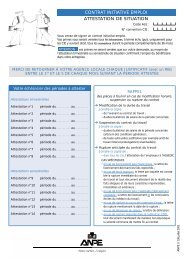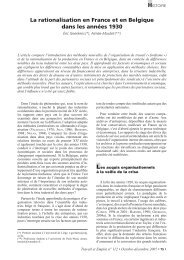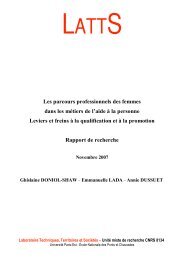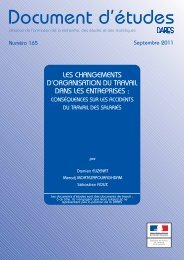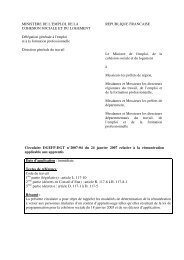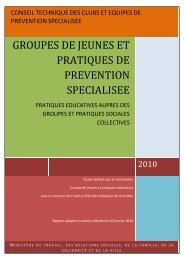Les patients en service de soins infirmiers à domicile (SSIAD)
Les patients en service de soins infirmiers à domicile (SSIAD)
Les patients en service de soins infirmiers à domicile (SSIAD)
You also want an ePaper? Increase the reach of your titles
YUMPU automatically turns print PDFs into web optimized ePapers that Google loves.
Cadrage <strong>Les</strong> <strong>SSIAD</strong> <strong>de</strong> <strong>de</strong> l’évaluation l’étu<strong>de</strong> <strong>de</strong>s PRSP<br />
Dans cette section, nous prés<strong>en</strong>tons les caractéristiques <strong>de</strong>s 36 <strong>SSIAD</strong> ret<strong>en</strong>us pour l’analyse<br />
<strong>de</strong>s données.<br />
Nombre <strong>de</strong> places et fédération d’appart<strong>en</strong>ance<br />
Le nombre <strong>de</strong> places installées médian est <strong>de</strong> 43, la moy<strong>en</strong>ne atteint 62. Trois <strong>service</strong>s<br />
ont un nombre <strong>de</strong> places supérieur <strong>à</strong> 150. Ces gros <strong>SSIAD</strong> sont surreprés<strong>en</strong>tés dans l’échantillon.<br />
Si on les exclut pour le calcul, le nombre moy<strong>en</strong> <strong>de</strong> places <strong>de</strong> l’échantillon est <strong>de</strong> 41,<br />
chiffre qui correspond au nombre moy<strong>en</strong> <strong>de</strong> places <strong>de</strong>s <strong>SSIAD</strong> dans l’étu<strong>de</strong> conduite par la<br />
DREES <strong>en</strong> 2002 24 .<br />
Près <strong>de</strong> la moitié <strong>de</strong>s <strong>SSIAD</strong> ont <strong>en</strong>tre 30 et 49 places (voir Tableau 3).<br />
Tableau 3 : Nombre <strong>de</strong> <strong>SSIAD</strong> par catégorie <strong>de</strong> taille<br />
Nombre <strong>de</strong> places installées Nombre <strong>de</strong> <strong>SSIAD</strong> %<br />
jusqu’<strong>à</strong> 20 places 1 2,8<br />
<strong>de</strong> 20 <strong>à</strong> 29 places 7 19,4<br />
<strong>de</strong> 30 <strong>à</strong> 49 places 16 44,4<br />
<strong>de</strong> 50 <strong>à</strong> 69 places 7 19,4<br />
<strong>de</strong> 70 <strong>à</strong> 99 places 2 5,6<br />
plus <strong>de</strong> 100 places 3 8,3<br />
Total 36 100<br />
<strong>Les</strong> <strong>SSIAD</strong> adhér<strong>en</strong>ts <strong>de</strong> la FEHAP sont majoritaires, ils représ<strong>en</strong>t<strong>en</strong>t 39 % <strong>de</strong>s <strong>service</strong>s et<br />
accueill<strong>en</strong>t 62 % <strong>de</strong>s <strong>pati<strong>en</strong>ts</strong> <strong>de</strong> l’étu<strong>de</strong>. Leur nombre <strong>de</strong> places est <strong>en</strong> moy<strong>en</strong>ne plus élevé<br />
que celui <strong>de</strong>s <strong>de</strong>ux autres fédérations car les trois plus gros <strong>SSIAD</strong> <strong>de</strong> l’étu<strong>de</strong> adhérant <strong>à</strong><br />
cette fédération. Si on retire ces <strong>de</strong>rniers <strong>de</strong> l’analyse, la taille moy<strong>en</strong>ne <strong>de</strong>s autres <strong>SSIAD</strong><br />
FEHAP se rapproche <strong>de</strong> la moy<strong>en</strong>ne <strong>de</strong> l’échantillon (47 places) et la médiane <strong>en</strong> est id<strong>en</strong>tique<br />
(43). <strong>Les</strong> <strong>SSIAD</strong> adhér<strong>en</strong>ts ADMR sont, quant <strong>à</strong> eux, plus nombreux dans l’étu<strong>de</strong> mais,<br />
<strong>de</strong> moindre taille, ils représ<strong>en</strong>t<strong>en</strong>t seulem<strong>en</strong>t 31 % <strong>de</strong>s places. Enfin 3 <strong>SSIAD</strong> d’une taille<br />
moy<strong>en</strong>ne <strong>de</strong> 49 places adhérant <strong>à</strong> la Fédération À <strong>domicile</strong> ont participé.<br />
Si l’on compare notre échantillon <strong>à</strong> la population totale <strong>de</strong>s <strong>SSIAD</strong>, on note une nette<br />
sous représ<strong>en</strong>tation dans notre étu<strong>de</strong> <strong>de</strong>s petits <strong>SSIAD</strong> <strong>de</strong> moins <strong>de</strong> 20 places et <strong>de</strong> façon<br />
moindre <strong>de</strong>s <strong>service</strong>s <strong>de</strong> 70 <strong>à</strong> 99 places. En revanche, les <strong>SSIAD</strong> <strong>de</strong> 30 <strong>à</strong> 49 places et surtout<br />
les grands <strong>service</strong>s <strong>de</strong> plus <strong>de</strong> 100 places sont surreprés<strong>en</strong>tés. La distribution <strong>de</strong>s places<br />
24. Sophie Bressé, « <strong>Les</strong> <strong>service</strong>s <strong>de</strong> <strong>soins</strong> <strong>infirmiers</strong> <strong>à</strong> <strong>domicile</strong> (<strong>SSIAD</strong>) et l’offre <strong>de</strong> <strong>soins</strong> <strong>infirmiers</strong> aux personnes âgées <strong>en</strong><br />
2002 », in Étu<strong>de</strong>s et résultats, n° 350, novembre 2004.<br />
21



